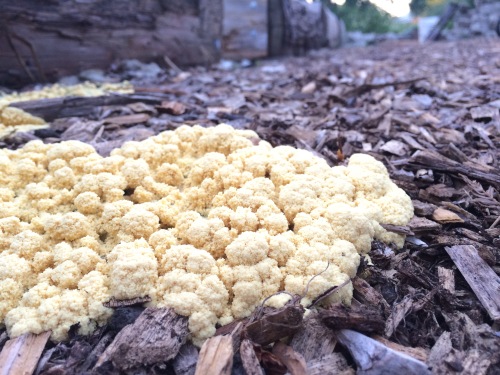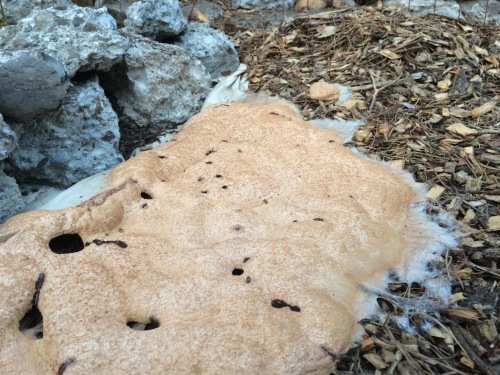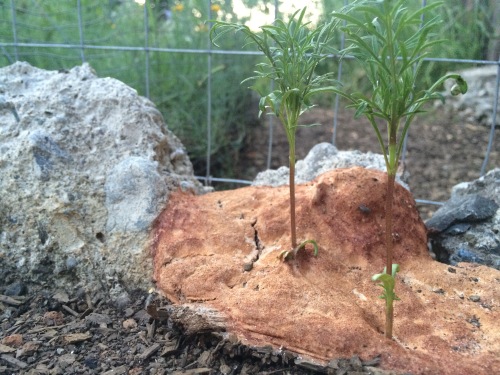Yep, you read that title right. Dog Vomit Fungus. My garden has it ALL OF THE PLACES!!! Also known as scrambled eggs fungus, it basically looks like the dog was sick all over the place. I’ve taken up calling it mulch puke. 
Technically a slime mold, dog vomit fungus usually appears in clumps, growing on mulch, the bases of rotting tree trunks, or other wooden objects. It is most often found in moist, shady areas. We’ve had small spots of it earlier this spring, but today is was everywhere. Why it decided to colonize on the first almost 100 degree day we had, I don’t know, but apparently my garden is a desirable place for it. 
Slime molds reproduce by spores that travel by wind. Apparently, they are very resistant, and can survive even during hot, dry weather. The spores can remain viable for several years, waiting for conditions to be right. When conditions are ideal, dormant spores absorb moisture and crack open to release a swarm sphere, and shortly after, the dog vomit appears. It is light yellow when its young, and textured like cauliflower or those old-school Magic Crystal Gardens. As it ages, it turns more brown and firm, eventually developing these yellow streaks that look like gel icing or egg yolk, which I’m pretty sure are the reproductive organs. Sadly I don’t have a picture to share. You’ll just have to imagine it. 
Normally I don’t care about fungi that show up in my yard; I actually get excited because it means my soil is alive. Fungus and mushrooms are not diseases, but are organisms that are eating decomposing materials. While not fungi, this slime mold plays the same ecosystem roll. Since I use lots of arbor mulch, I’m not surprised to find it eating up my pathways. One more factor that is improving my soil! In addition to my mulched paths, I’ve also found it on top of the soil in my beds and on the edges of the beds. 
Although rare, dog vomit can smother plants if the colony gets big enough. I’m observing it spread right over some of my seedlings and plants, but they seem to be doing fine. The recommendations for getting rid of it is to change out the mulch, or rake out the best you can. It isn’t toxic, so all of that seems way to much effort for something not that big of a deal, that probably won’t go away anyways. So other than poking at it with a stick and proclaiming how weird it is, I’m just letting it be. If you come by my house, don’t worry, Stella is as healthy as can be. Its just the dog vomit fungus!

never knew!
OK… Question time.
I have been told that you can tip some kinds of fungi straight into your compost bin and it will speed up your composting (Because the fungi will also eat it).
So is it worth padding out any bins you have with some of it?
From the reading I did, it was recommended not to, because then you would just spread the spores everywhere and it would take over wherever you spread the compost. If you were a good composter, and could get your pile hot enough, it could kill the spores, but my compost skills are lacking….
Ah.
I get why they said you *could* do it… because a good and hot compost would kill the spores.
But getting a hot compost is not so easy, mine is a cold compost too. *sigh* B-)
Fungi is rampant here this year as well. Oh, El Nino…
Ewww. Good on you to appreciate its finer qualities and let it be. I’m not sure I could do the same.
Love it! My kids call it cat puke or rotten mustard, but I think it’s the same thing. I get a lot of it in the chipping pile (where all the tree prunings go), but it doesn’t appear take hold in the paths I make of mulch in the garden space. I wonder why…
Thank you for the great picture and information. I have a huge growth and could not figure out how to describe it to identify it. I have never seen the hard lump stage. Mine is wet and looks just like cauliflower florettes, but I am pretty sure it is Dog Vomit.
Glad it could help! It certainly is strange to come across!